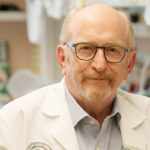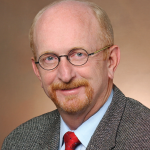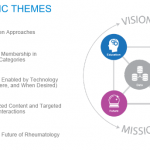“Without the Rheumatology Research Foundation, the field would not be nearly as advanced as it is today, and that is in large part because our Foundation has been able to support high-risk, high-reward ideas, as well as the workforce to carry them out,” says Rheumatology Research Foundation President V. Michael Holers, MD.

Dr. Holers
Now in the second year of his 2021–2023 term as Foundation president, Dr. Holers, a professor of medicine and immunology and the Smyth Professor of Rheumatology at the University of Colorado, Denver, is looking forward to fortifying and expanding those missions in the framework of the Foundation’s new strategic plan.
Growing the Rheumatology Workforce
The 2022–2027 strategic plan has three major focus areas. One is to build the number of rheumatologists and advanced practice providers (APPs), particularly among under-represented groups, according to Dr. Holers.
“While we have a lot more to do, we have made substantial progress in these areas. A good illustration of that progress is the Foundation’s collection of innovative grant mechanisms that open up funding to support nurse practitioners and other APPs. Indeed, we have found that APPs who get this support are more likely to remain with their rheumatology practices, and retention is a significant goal,” he says.
In addition, the Foundation is taking steps to recruit early career medical students into the field. “This is a critical emphasis. We have a wide variety of funding mechanisms in place to interest medical students in rheumatology and to support training in rheumatology. And we’re trying to actually move those efforts earlier—into college, possibly high school—to expose students to the excitement of the field.” (More about the extensive range of student and early career grants is available here: https://www.rheumresearch.org/funding-opportunities.)
This priority on the workforce is designed not only to lessen demands on already practicing rheumatologists, but also to widen access to patient care. For example, Dr. Holers notes that patients in rural areas often have to drive tens and sometimes hundreds of miles to visit a rheumatology specialist.
“Improved patient access and outcomes can happen with increased numbers of providers,” says Dr. Holers. “And along those lines of improving access, we are working to advance telehealth. In fact, telehealth is one of the new research areas we are pursuing through our Rheum2Collaborate telemedicine partnership.” (Note: The partnership is funded by AbbVie and UCB with additional support from Bristol Myers Squibb.)
Driving Research
In terms of research overall, a second focus area of the Foundation’s strategic plan stresses funding the best science, fostering innovation and encouraging collaboration.
“The Foundation has always been extraordinarily successful in supporting the kind of high-risk, high-reward research projects that can be hard to get funded otherwise, and have gone on to have big impacts even beyond our field,” says Dr. Holers. “To that point, rheumatology is the subspecialty that pioneered the biologic therapies that are being used for so many diseases. One reason we were able to do that is because our Foundation has made a concerted effort to fund innovative ideas, along with supporting the researchers capable of that kind of advanced research.”
A particularly fruitful way for the Foundation to support innovative research has been through bridge funding that assists the often-difficult transition from training years to the early career period. “This is a strategy in which an early-career investigator has written a grant that has been reviewed very positively, but has not received funding for that cycle,” says Dr. Holers. “With bridge funding, the Foundation provides carryover support while that investigator reworks and resubmits the grant for the following cycle.
“A high proportion of these resubmitted grants are then successful. I’ve seen this approach validated myself. At the Rheumatology Research Foundation Investigators Meeting I attended in June 2022, it was amazing to see so many early career investigators presenting papers and also making a point of mentioning that both grant and bridge funding from the Foundation had allowed them to get their next proposals funded by the U.S. National Institutes of Health and move their careers ahead.”
To further solidify the Foundation’s focus on cutting-edge work, it is currently undergoing a portfolio review to ensure best practices in its grant mechanisms and to identify new research areas to explore through 2023. Already, Dr. Holers notes, the Foundation is exploring data sciences, omics and other advanced scientific technologies that lead to translational research advances and should improve patient outcomes.
Leveraging Partnerships
The third focus of the 2022–27 strategic plan deals with leveraging relationships to grow rheumatology. One aspect of this broad focus involves strengthening collaborations with other rheumatology organizations as well as subspecialty groups, such as nephrologists, ophthalmologists and dermatologists, who share in providing coordinated care for rheumatologic and autoimmune diseases.
“We want to take advantage of that clinical cross-fertilization and cultivate research across these subspecialties, again with the ultimate goal of improving outcomes for our patients,” says Dr. Holers. After all, he adds, these are very complicated and involve multiple systems, so the research should include input from multiple disciplines.
Beyond these objectives, Dr. Holers looks forward to participating with other members of the Foundation board and committees, its staff and dedicated volunteers to promote the Rheumatology Research Foundation in the coming year, while also clarifying the often-misunderstood connection between the Foundation and the ACR. The ACR and the Foundation work closely together, he says, but the ACR is a professional society, whereas the Foundation is a separate 501(c)(3) nonprofit organization, and the two organizations have different missions.
“At the Rheumatology Research Foundation, our mission is to support workforce development and research, and we are proud to be the second-largest funding source of rheumatology research and training programs in the U.S., behind only the National Institutes of Health,” says Dr. Holers. “As we move forward, we will continue to consider ways to advance research, build the workforce, and enhance our fundraising. Each one of those areas is an evolving discipline, and I look forward to discussing new ideas and approaches for each one, and integrating them into our programs.”
Leslie Mertz, PhD, is a freelance science journalist based in northern Michigan.



